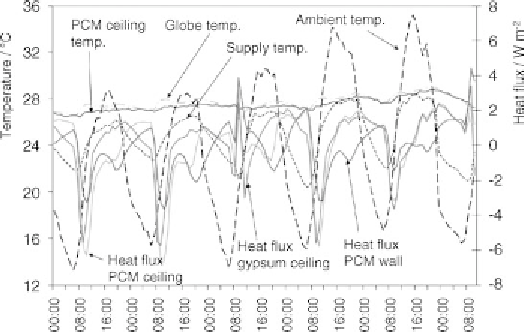Environmental Engineering Reference
In-Depth Information
Figure 3.20
Temperatures and heat fluxes on the top floor of the ebok building with a comparison of
PCM boards in the ceiling and wall and a conventional gypsum board. The measurements were taken
from 1 to 6 July 2006
temperature increase then occurs until the air outlets are reached. This high night sup-
ply air temperature level combined with rather low air exchange rates lead to night
heat fluxes of only 1-2Wm
−
2
. The effective measured heat storage capacity of the
PCMboards was therefore only 24Wh m
−
2
comparedwith 17Wh m
−
2
for the gypsum
board.
Despite the limitations in heat removal through mechanical night ventilation, sum-
mer comfort in the ebok building is generally acceptable. In summer 2005 with
220 hours of ambient temperatures above 25
◦
C, all rooms had very satisfactory room
air conditions, with 4.2% of all office hours above 26
◦
C with a maximum of 7.7% (see
Figure 3.21). The total number of working hours is 2871 h.
In the warmer summer of 2006 (e.g. with a mean ambient temperature in July of
4 K higher than average) 10.6% of all office hours had more than 26
◦
C room air
temperatures with maximum values of 16.6%. With monthly average temperatures of
23
.
5
◦
C in July, a room air temperature level of 27
◦
C is considered acceptable, but
here only 6% of all office hours are above 27
◦
C (see Figure 3.22). Although the night
ventilation concept could be improved with higher night air flows and lower supply
air temperatures, the building functioned well in both summer and winter and had
an extremely low total primary energy consumption of 50 kWh m
−
2
a
−
1
for heating,
lighting, ventilation and auxiliary electricity consumption.
3.3 Summary of Passive Cooling
New experimental results for night ventilation are presented for some of the energet-
ically best European office buildings today.

Search WWH ::

Custom Search